Shell Seeker Sweater |
|||||||||||||||||||||||||||||||
 |
 |
||||||||||||||||||||||||||||||
Crocheted sweater in DROPS Belle. The piece is worked bottom up with lace pattern and bobbles. Sizes S - XXXL.
DROPS 240-3 |
|||||||||||||||||||||||||||||||
|
------------------------------------------------------- EXPLANATIONS FOR THE PATTERN: ------------------------------------------------------- CHAIN STITCH: If you work outermost on the hook the chain stitch will often be too tight; 1 chain stitch should be as long as 1 single/douvle crochet is wide. CROCHET INFORMATION: Each row starts with 1 chain stitch, which does not replace the first stitch. PATTERN: See diagrams A.1 to A.7. MEASURING TIP: All measurements should be taken while holding the piece up as the garment will stretch when worn. ------------------------------------------------------- START THE PIECE HERE: ------------------------------------------------------- SWEATER – SHORT OVERVIEW OF THE PIECE: The back, front and sleeves are worked separately, back and forth and bottom up. The piece is assembled and the neck worked to finish. BACK PIECE: Work 102-122-122-142-142-162 CHAIN STITCHES – read description above, with hook size 4 MM = US 6 and DROPS Belle. Work 1 single crochet in the 2nd chain stitch from the hook, then 1 single crochet in each chain stitch = 101-121-121-141-141-161 single crochets + 1 chain stitch – read CROCHET INFORMATION. Work the next row as follows from the right side: Work A.1 over the first 11 single crochets, A.2 8-10-10-12-12-14 times, A.3 over the last 10 single crochets. Continue this pattern back and forth. REMEMBER THE CROCHET GAUGE! When the first 2 rows (A) in A.1/A.2/A.3 are finished, work the 4 rows (B) 4 times in height then 4 rows (C) 1 time. This pattern is now finished and the piece measures approx. 18 cm = 7" from the cast-on edge. Work the next row as follows from the right side: Work A.4, A.5 5-6-6-7-7-8 times (make sure the pattern matches the stitches below), A.6. Continue this pattern back and forth. When the piece measures 28-30-30-32-31-33 cm = 11"-11¾"-11¾"-12½"-12¼"-13" – read MEASURING TIP, and you are on a row of only chain-spaces and single crochets, work the armholes on each side as follows: Cut the strand, turn, skip the first 3 chain-spaces (3 chain-spaces + 3 single crochets) (= 1/2 a repeat of A.5), work A.5 over the next 24-30-30-36-36-42 chain-spaces (start and finish the row with A.4/A.6 as before), do not work the last 3 chain-spaces on the row (= 1/2 repeat of A.5). Continue this pattern back and forth. When the piece measures 42-44-45-47-48-50 cm = 16½"-17¼"-17¾"-18½"-19"-19¾", work chain-spaces/single crochets back and forth as before over all stitches, without working bobbles. When the piece measures 45-47-49-51-53-55 cm = 17¾"-18½"-19¼"-20"-21"-21⅝" and the next row is from the right side – remember MEASURING TIP, work the shoulders as follows: Work back and forth as before over the first 7-10-9-12-11-14 chain-spaces (start and finish the row with A.4/A.6 as before). Cut and fasten the strand when the piece measures 48-50-52-54-56-58 cm = 19"-19¾"-20½"-21¼"-22"-22¾". Turn, start from the wrong side and work the other shoulder in the same way (do not work the middle 10-10-12-12-14-14 chain-spaces = neck). FRONT PIECE: Work in the same way as the back until the front piece measures 42-44-45-47-48-50 cm = 16½"-17¼"-17¾"-18½"-19"-19¾". Now work chain-spaces/single crochets back and forth over all stitches, without working bobbles. In addition, work the neck as follows: Start from the right side and work the first 10-13-12-15-14-17 chain-spaces as shown in A.7, turn and work back (A.7 only shows size S, but the decreases are the same in all sizes, work the correct number of chain-spaces for your size and follow A.7 for working the neck). You work 1 less chain-space at the end of every 2nd row 3 times as shown in A.7 = 7-10-9-12-11-14 chain-spaces on the shoulder. Work chain-spaces until the piece measures 48-50-52-54-56-58 cm = 19"-19¾"-20½"-21¼"-22"-22¾". Cut and fasten the strand. Turn, start from the wrong side and work the other shoulder in the same way. SLEEVES: Work 82-82-82-82-102-102 chain stitches with hook size 4 MM = US 6 and DROPS Belle. Work 1 single crochet in the 2nd chain stitch from the hook, then 1 single crochet in each chain stitch = 81-81-81-81-101-101 single crochets + 1 chain stitch. Work the next row as follows from the right side: Work A.1 over the first 11 stitches, A.2 6-6-6-6-8-8 times, A.3 over the last 10 stitches. Continue this pattern back and forth. When the first 2 rows (A) in A.1/A.2/A.3 are finished, work the 4 rows (B) 2 times in height then 4 rows (C) 1 time. This pattern is now finished and the piece measures approx. 11 cm = 4⅜" from the cast-on edge. Work the next row as follows from the right side: Work A.4, A.5 4-4-4-4-5-5 times (make sure the pattern matches A.2), work A.6 = 24-24-24-24-30-30 chain-spaces. Continue this pattern back and forth. SIZES S, M, XXL and XXXL: When the piece measures 47-43-41-37 cm = 18½"-17"-16⅛"-14½", work chain-spaces/single crochets back and forth over all stitches without working bobbles. Work until the sleeve measures 52-48-46-42 cm = 20½"-19"-18"-16½". Cut and fasten the strand. Work the other sleeve in the same way. SIZES L and XL: When the piece measures 14 cm = 5½", increase 1 chain-space on one side of the piece by working 1 chain-space + 1 single crochet extra in the first chain-space on the row. Repeat this increase in the last chain-space on the row when the sleeve measures 28 cm = 11" = 26-26 chain-spaces. When the piece measures 44-40 cm = 17¼"-15¾", work chain-spaces/single crochets back and forth over all stitches without working bobbles. Work until the sleeve measures 49-45 cm = 19¼"-17¾". Cut and fasten the strand. Work the other sleeve in the same way. ASSEMBLY: Lay the front and back pieces together, wrong side to wrong side and work one shoulder seam as follows: * 1 single crochet around the first/next chain-space on the front piece, 1 chain stitch, 1 single crochet around the first/next chain-space on the back piece, 1 chain stitch *, work from *-* along the shoulder, finish with 1 single crochet in the last stitch. Cut and fasten the strand. Work the other shoulder seam in the same way. Work the side seams as follows: 1 single crochet in the first stitch on the front piece, 2 chain stitches, 1 single crochet in the first stitch on the back piece, * 2 chain stitches, skip 1 cm = ⅜", 1 single crochet around the next stitch on the front piece, 2 chain stitches, skip 1 cm = ⅜", 1 single crochet around the next stitch on the back piece *, work from *-* along the side. Work the sleeve seams from the bottom as follows: 1 single crochet in the first stitch on one side of the sleeve, 2 chain stitches, 1 single crochet in the first stitch on the other side of the sleeve, * 2 chain stitches, skip 1 cm = ⅜", 1 single crochet in the next stitch on one side of the sleeve, 2 chain stitches, skip 1 cm = ⅜", 1 single crochet in the next stitch on the other side of the sleeve *, work from *-* until there is 5 cm = 2" left at the top of the sleeve. Cut and fasten the strand. Work the sleeve cap to the armhole as follows: * 1 single crochet around the first/next chain-space on front/back piece, 2 chain stitches, 1 single crochet around the first/next chain-space on sleeve cap, 2 chain stitches *, work from *-* around the armhole. Then work the split at the top of the sleeve to the bottom of the armhole – see sketch. NECK: Start from the right side on one shoulder, work 1 single crochet in the first stitch, * 3 chain stitches, skip 1½ cm = ½", 1 single crochet around the next stitch/chain-space *, work from *-* around the neck. Finish with 3 chain stitches and 1 slip stitch in the first single crochet on the round. Cut and fasten the strand. |
|||||||||||||||||||||||||||||||
Diagram explanations |
|||||||||||||||||||||||||||||||
|
|||||||||||||||||||||||||||||||

|
|||||||||||||||||||||||||||||||
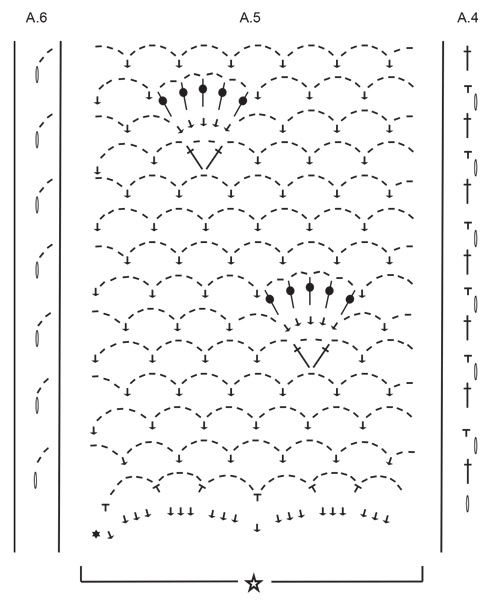
|
|||||||||||||||||||||||||||||||
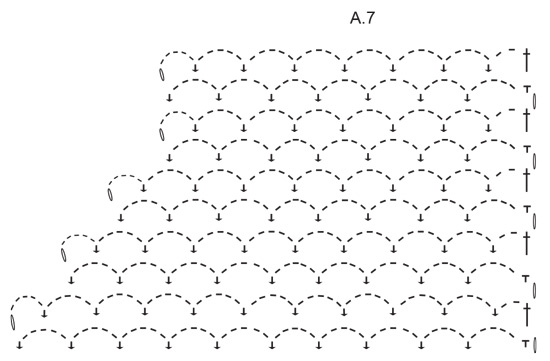
|
|||||||||||||||||||||||||||||||

|
|||||||||||||||||||||||||||||||

|
|||||||||||||||||||||||||||||||
|
Have you made this or any other of our designs? Tag your pictures in social media with #dropsdesign so we can see them! Do you need help with this pattern?You'll find tutorial videos, a Comments/Questions area and more by visiting the pattern on garnstudio.com. © 1982-2024 DROPS Design A/S. We reserve all rights. This document, including all its sub-sections, has copyrights. Read more about what you can do with our patterns at the bottom of each pattern on our site. |
|||||||||||||||||||||||||||||||









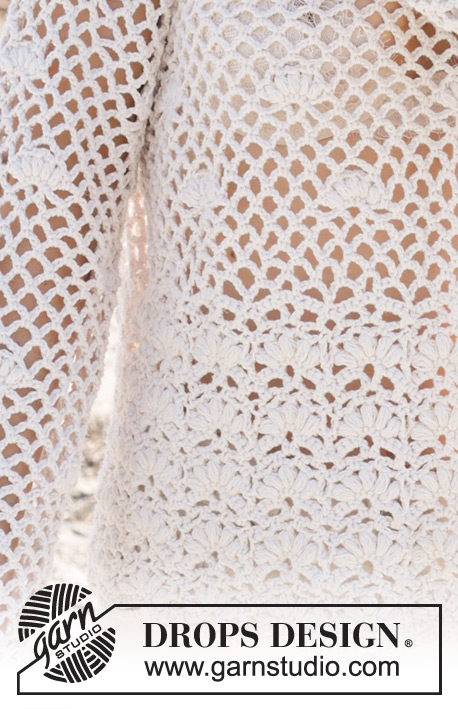




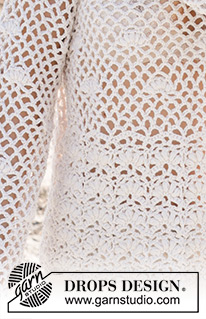































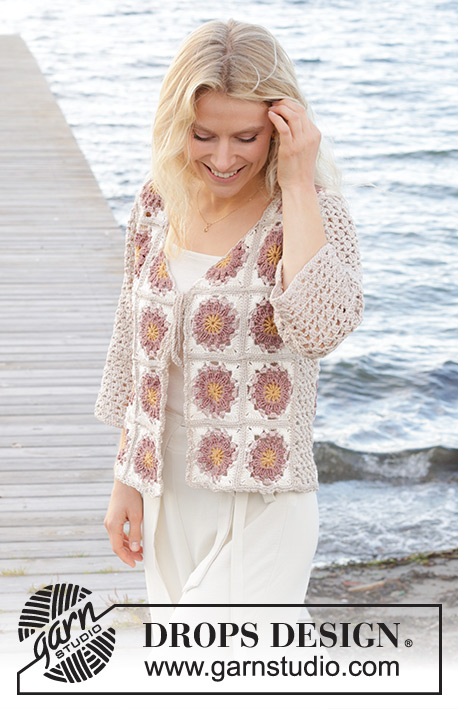






Comments / Questions (30)
I’m not understanding the assembly of the sweater very well. Is it possible to do a video of assembling or a video that has the type of assembling that is the same so I can watch and follow
27.10.2023 - 11:16DROPS Design answered:
Dear Mrs Pultrone, this video we show how to crochet two pieces together almost the same way as explained in this pattern, expect crocheting in the stitches from previous row crochet in the chain spaces as explained in this pattern and crochet only 2 chains instead of 4 here. Happy crocheting!
28.10.2023 - 08:13Hallo ich habe schon mehrere Anleitungen von Drops Design gehäkelt, immer mit Erfolg. Bei dieser sieht das anders aus wie auf den Bildern, ab A4, 5,6, wird das Teil viel weiter, die Luftmaschenbögen stimmen aber mit der Vorlage überein, ist das normal??? Grüße von Manu
15.09.2023 - 13:37DROPS Design answered:
Liebe Manu, die ersten Diagramme A.1, A.2 und A.3 werden etwas fester gehäkelt - A.5 x 1 Mal in der Breite muss ca 10 cm sein,benutzen Sie eine kleinere Häkelnadel dafür wenn es nötig ist. Viel Spaß beim häkeln!
15.09.2023 - 15:53Bonjour, J'ai fait le dos et le devant sans soucis. Je cherche une vidéo pas a pas pour faire les augmentations des manches Merci de me dire s'il existe un lien
14.07.2023 - 16:24DROPS Design answered:
Bonjour Liliane, nous n'avons pas de video correspondante. Les augmentations des manches ne sont realisees que dans les tailles L et XL - vous devez augmenter 1 arceau d'un côté de l'ouvrage en crochetant 1 arceau + 1 maille serrée en plus dans le premier arceau au début du rang. Répéter cette augmentation dans le dernier arceau du rang quand la manche mesure 28 cm. Bon crochet!
17.07.2023 - 23:20Hallo! Muss nochmal nachfragen. Habe Rücken- und Vorderteil fertig. Auf dem Foto sieht man 5 x Noppen in der Höhe, also A5. Ich komme beim Rücken auf 4 x Noppen und beim Vordergeil nur auf 3 x Noppen in der Höhe. Die Maße passen aber, also Gesamtlänge ca. 50 cm. Kann das sein? LG
22.06.2023 - 17:51DROPS Design answered:
Liebe Gitte, es kann wegen Maschenprobe sein, aber so wichtig ist es aber nicht, das wichtigste ist, daß die Maßen richtig sind. Viel Spaß beim häkeln!
23.06.2023 - 07:34Hallo zusammen. Habe schon einige Anleitungen von Euch gehäkelt. Aber bei dieser habe ich irgendwie Schwierigkeiten. Lt. Anleitung sollen ab ca. 44 cm keine Noppen mehr gehäkelt werden. Wenn ich das Foto ansehe, gehen diese aber bis oben hin. Muss ich nicht im Musterverlauf bleiben? Arbeite mit Nadelstärke 3. Bei 4 kamen die Maße nicht hin. Danke im Voraus. LG
20.06.2023 - 15:05DROPS Design answered:
Liebe Gitte, so wird es gehäkelt, damit man keine unfertige Noppen bei den Schultern hat, so sind die 6 letzten centimers bei den Schultern ohne Noppen - dh genauso wie beim Foto. Viel Spaß beim häkeln!
20.06.2023 - 15:43Goedemiddag ik ben bij het rugpand en nu moet ik beginnen aan het armsgat maar snap het niet.Moet ik opnieuw opstarten aan de kant waar ik geeindigt ben(heb draad afgeknipt).en moet ik dan in een lus beginnen of in de 4de vaste?
29.05.2023 - 12:14DROPS Design answered:
Dag Diane,
Je knipt inderdaad de draad af en keert het werk. Dan sla je de eerste 3 lossenlussen over en hecht je aan met een halve vaste in de vaste. Je haakt nu ook weer A.4 en A.6 aan het begin/einde van de toer en in plaats van 1 stokje haak je nu 3 lossen aan het begin om het stokje te vervangen.
01.06.2023 - 13:04Hoe komt het dat bij de mouwen l meer toeren nodig heeft dan xl dat lijkt mij onlogisch
28.05.2023 - 12:33DROPS Design answered:
Dag Els,
Dat komt omdat maat xl een grotere pas heeft, waardoor de mouwen korter zijn.
29.05.2023 - 15:41Je zegt proeflap 18 vasten op 18 toeren is 10 cm op 10 cm en voor maat xxl heb ik 141 vasten nodig voor de rug jullie zeggen dat ik dan op 60 cm moet uitkomen maar ik kom op 78 cm uit ook als ik het uitreken op mijn rekenmachine en voor maat s kom ik uit op 56cm in plaats van 40cm wat doe ik mis gelieve mij de helpen bedankt
24.05.2023 - 18:32DROPS Design answered:
Dag Els,
Wanneer je begint met het haken van de telpatronen, krimpt het werk een beetje in elkaar omdat er boogjes ontstaan aan de onderkant. Op die manier kom je, als het goed is, alsnog op de juiste maat uit.
24.05.2023 - 21:08Pour la mesure du dos c’est 28cm à partir de la chaînette de base ou après les 18 cm merci
20.05.2023 - 21:19DROPS Design answered:
Bonjour Mme Goullier, les 28 cm pour l'emmanchure en taille S se mesurent à partir de la chaînette de base. Bon crochet!
22.05.2023 - 08:20Pouvez vous me dire à quel tour de poitrine correspond la taille s je suis perdue merci
10.05.2023 - 09:41DROPS Design answered:
Bonjour Mme Goullier, pour trouver votre taille, mesurez un vêtement similaire que vous avez et dont vous aimez la forme, et comparez ces mesures à celles du schéma du bas de page; vous pourrez ainsi choisir l'ampleur nécessaire en fonction de vos propres mesures. Retrouvez plus d'infos ici. Bon crochet!
10.05.2023 - 16:32